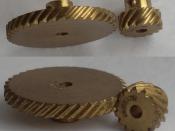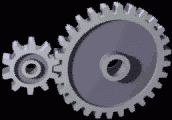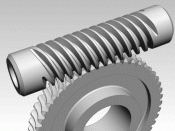Gear, toothed wheel or cylinder used to transmit rotary or reciprocating motion from one part of a machine to another. Two or more gears, transmitting motion from one shaft to another, constitute a gear train. At one time various mechanisms were collectively called gearing. Now, however, the word gearing is used only to describe systems of wheels or cylinders with meshing teeth. Gearing is chiefly used to transmit rotating motion, but can, with suitably designed gears and flat-toothed sectors, be employed to transform reciprocating motion into rotating motion, and vice versa.
Simple Gears
The simplest gear is the spur gear, a wheel with teeth cut across its edge parallel to the axis. Spur gears transmit rotating motion between two shafts or other parts with parallel axes. In simple spur gearing, the driven shaft revolves in the opposite direction to the driving shaft. If rotation in the same direction is desired, an idler gear is placed between the driving gear and the driven gear.
The idler revolves in the opposite direction to the driving gear and therefore turns the driven gear in the same direction as the driving gear. In any form of gearing the speed of the driven shaft depends on the number of teeth in each gear. A gear with 10 teeth driving a gear with 20 teeth will revolve twice as fast as the gear it is driving, and a 20-tooth gear driving a 10-tooth gear will revolve at half the speed. By using a train of several gears, the ratio of driving to driven speed may be varied within wide limits.
Internal, or annular, gears are variations of the spur gear in which the teeth are cut on the inside of a ring or flanged wheel rather than on the outside. Internal gears usually drive or are...


